Capillary Flow-Driven and Magnetically Actuated Multi-Use Wax Valves for Controlled Sealing and Releasing of Fluids on Centrifugal Microfluidic Platforms
Abstract
:1. Introduction
- The previous wax valves [14] can only be used once, either from the off to on configuration or from on to off configuration.
- There are twice the number of valves required for performing the same function as done by our design due to the need for separate valves for on and off functions.
- Other designs require more space on the CD, which makes the fabrication more expensive and laborious.
2. Materials and Methods
2.1. Characterization of the Ferrowax
2.2. Design and Fabrication of Ferrowax Valves
2.2.1. Valve Fabrication
2.2.2. Capillary Force-Driven Wax Valve Operation
2.2.3. Magnet Wax Valve Fabrication
2.3. Simulation of Capillary Wax Valves
2.4. Experimental Setup
3. Results and Discussion
3.1. Operation of the Capillary Wax Valve
3.1.1. Functional Tests of Capillary Wax Valves
3.1.2. Theoretical Analysis of the Solidification Time of Ferrowax Plugs
3.1.3. Theoretical Analysis of the Dynamics of Opening of the Ferrowax Valve
3.1.4. Theoretical Analysis of the Time to Melt the Wax
3.1.5. Analysis of the Wax Plug Advancement in the Channel
3.1.6. Effect of Valve Convergence Angle on Response Time of Wax Capillary Valve
3.1.7. Effect of Valve Area of Capillary Path
3.2. Operation of the Magnet-Actuated Ferrowax Valve
Functional Testing of the Magnet-Actuated Ferrowax Valve
4. Conclusions
5. Patents
Supplementary Materials
Author Contributions
Funding
Institutional Review Board Statement
Informed Consent Statement
Data Availability Statement
Acknowledgments
Conflicts of Interest
References
- Amasia, M.; Madou, M. Large-volume centrifugal microfluidic device for blood plasma separation. Bioanalysis 2010, 2, 1701–1710. [Google Scholar] [CrossRef] [PubMed] [Green Version]
- Noroozi, Z.; Kido, H.; Peytavi, R.; Nakajima-Sasaki, R.; Jasinskas, A.; Micic, M.; Felgner, P.L.; Madou, M.J. A multiplexed immunoassay system based upon reciprocating centrifugal microfluidics. Rev. Sci. Instrum. 2011, 82, 64303. [Google Scholar] [CrossRef] [PubMed] [Green Version]
- Pal, R.; Yang, M.; Johnson, B.N.; Burke, D.T.; Burns, M.A. Phase Change Microvalve for Integrated Devices. Anal. Chem. 2004, 76, 3740–3748. [Google Scholar] [CrossRef]
- Kim, J.; Kido, H.; Rangel, R.H.; Madou, M.J. Passive flow switching valves on a centrifugal microfluidic platform. Sens. Actuators B Chem. 2008, 128, 613–621. [Google Scholar] [CrossRef]
- Cho, H.; Kim, H.-Y.; Kang, J.Y.; Kim, T.S. How the capillary burst microvalve works. J. Colloid Interface Sci. 2007, 306, 379–385. [Google Scholar] [CrossRef]
- Gorkin, R., 3rd; Nwankire, C.E.; Gaughran, J.; Zhang, X.; Donohoe, G.G.; Rook, M.; O’Kennedy, R.; Ducree, J. Centrifugo-pneumatic valving utilizing dissolvable films. Lab Chip 2012, 12, 2894–2902. [Google Scholar] [CrossRef] [PubMed]
- McNeely, M.R.; Spute, M.K.; Tusneem, N.A.; Oliphant, A.R. Hydrophobic microfluidics. In Proceedings of the Microfluidic Devices and Systems II, International Society for Optics and Photonics, Santa Clara, CA, USA, 19 August 1999; pp. 210–220. Available online: https://www.spiedigitallibrary.org/conference-proceedings-of-spie/3877/0000/Hydrophobic-microfluidics/10.1117/12.359339.short (accessed on 11 February 2021).
- Ekstrand, G.; Holmquist, C.; Örlefors, A.E.; Hellman, B.; Larsson, A.; Andersson, P. Microfluidics in a Rotating CD. In Micro Total Analysis Systems 2000; van den Berg, A., Olthuis, W., Bergveld, P., Eds.; Springer: Dordrecht, The Netherlands, 2000; pp. 311–314. [Google Scholar]
- Andersson, P.; Jesson, G.; Kylberg, G.; Ekstrand, G.; Thorsén, G. Parallel Nanoliter Microfluidic Analysis System. Anal. Chem. 2007, 79, 4022–4030. [Google Scholar] [CrossRef] [Green Version]
- Siegrist, J.; Gorkin, R.; Clime, L.; Roy, E.; Peytavi, R.; Kido, H.; Bergeron, M.; Veres, T.; Madou, M. Serial siphon valving for centrifugal microfluidic platforms. Microfluid Nanofluid 2010, 9, 55–63. [Google Scholar] [CrossRef] [Green Version]
- Kido, H.; Micic, M.; Smith, D.; Zoval, J.; Norton, J.; Madou, M. A novel, compact disk-like centrifugal microfluidics system for cell lysis and sample homogenization. Colloids Surf. B Biointerfaces 2007, 58, 44–51. [Google Scholar] [CrossRef]
- Schembri, C.T.; Burd, T.L.; Kopf-Sill, A.R.; Shea, L.R.; Braynin, B. Centrifugation and capillarity integrated into a multiple analyte whole blood analyser. J. Autom. Chem. 1995, 17, 99–104. [Google Scholar] [CrossRef]
- Steigert, J.; Brenner, T.; Grumann, M.; Riegger, L.; Lutz, S.; Zengerle, R.; Ducree, J. Integrated siphon-based metering and sedimentation of whole blood on a hydrophilic Lab-on-a-disk. Biomed. Microdevices 2007, 9, 675–679. [Google Scholar] [CrossRef] [PubMed]
- Park, J.-M.; Cho, Y.-K.; Lee, B.-S.; Lee, J.-G.; Ko, C. Multifunctional microvalves control by optical illumination on nanoheaters and its application in centrifugal microfluidic devices. Lab Chip 2007, 7, 557–564. [Google Scholar] [CrossRef]
- Garcia-Cordero, J.L.; Kurzbuch, D.; Benito-Lopez, F.; Diamond, D.; Lee, L.P.; Ricco, A.J. Optically addressable single-use microfluidic valves by laser printer lithography. Lab Chip 2010, 10, 2680–2687. [Google Scholar] [CrossRef] [PubMed] [Green Version]
- Carpentras, D.; Kulinsky, L.; Madou, M. A Novel Magnetic Active Valve for Lab-on-CD Technology. J. Microelectromech. Syst. 2015, 24, 1322–1330. [Google Scholar] [CrossRef]
- Grover, W.H.; Skelley, A.M.; Liu, C.N.; Lagally, E.T.; Mathies, R.A. Monolithic membrane valves and diaphragm pumps for practical large-scale integration into glass microfluidic devices. Sens. Actuators B Chem. 2003, 89, 315–323. [Google Scholar] [CrossRef]
- Kaigala, G.V.; Hoang, V.N.; Backhouse, C.J. Electrically controlled microvalves to integrate microchip polymerase chain reaction and capillary electrophoresis. Lab Chip 2008, 8, 1071–1078. [Google Scholar] [CrossRef] [PubMed]
- Oh, K.W.; Namkoong, K.; Park, C. A phase change microvalve using a meltable magnetic material: Ferro-wax. Micro Total Anal. Syst. 2005, 1, 554–556. [Google Scholar]
- Peshin, S.; George, D.; Shiri, R.; Madou, M. Reusable Capillary Flow-Based Wax Switch Valve for Centrifugal Microfluidics. ECS Meet. Abstr. 2021, MA2021-01, 1611. [Google Scholar] [CrossRef]
- Arashiro, E.Y.; Demarquette, N.R. Use of the pendant drop method to measure interfacial tension between molten polymers. Mat. Res. 1999, 2, 23–32. [Google Scholar] [CrossRef]
- Abramoff, M.D.; Magalhães, P.J.; Ram, S.J. Image processing with ImageJ. Biophotonics Int. 2004, 11, 36–42. [Google Scholar]
- Viscosity of Paraffin Wax—Viscosity Table and Viscosity Chart: Anton Paar Wiki. Anton Paar. Available online: https://wiki.anton-paar.com/en/paraffin-wax/ (accessed on 4 September 2021).
- Ferrite (Ceramic) Magnet Material/Eclipse Magnetics. Available online: https://www.eclipsemagnetics.com/en-us/products/magnetic-materials-and-assemblies/magnet-materials/ferrite-ceramic-magnet-material/ (accessed on 17 October 2021).
- Chvorinov’s Rule. In Wikipedia; 2021; Available online: https://en.wikipedia.org/w/index.php?title=Chvorinov%27s_rule&oldid=1013649395 (accessed on 30 October 2021).
- Jha, S.K.; Nallusamy, S.; Prabu, N.M. Study and analysis of thermal energy storage system using phase change materials (PCM). Int. J. Appl. Eng. Res. 2015, 10, 118–122. [Google Scholar]
- Thermal Conductivity Coefficients for Common Solids, Liquids and Gases. Available online: https://www.engineeringtoolbox.com/thermal-conductivity-d_429.html (accessed on 12 October 2021).
- Overview of Materials for Acrylic, Cast. Available online: http://www.matweb.com/search/datasheet.aspx?bassnum=O1303&ckck=1 (accessed on 30 October 2021).
- Chen, J.M.; Huang, P.-C.; Lin, M.-G. Analysis and experiment of capillary valves for microfluidics on a rotating disk. Microfluid Nanofluid 2008, 4, 427–437. [Google Scholar] [CrossRef]
- Agarwal, A.; Sarviya, R.M. Characterization of Commercial Grade Paraffin wax as Latent Heat Storage material for Solar dryers. Mater. Today Proc. 2017, 4 Pt A, 779–789. [Google Scholar] [CrossRef]
- Yang, B.; Lin, Q. A Latchable Phase-Change Microvalve with Integrated Heaters. J. Microelectromech. Syst. 2009, 18, 860–867. [Google Scholar] [CrossRef]
- Samy, R.A.; Suthanthiraraj, P.P.A.; George, D.; Iqbal, R.; Sen, A.K. Elastocapillarity-based transport of liquids in flexible confinements and over soft substrates. Microfluid. Nanofluidics 2019, 23, 100. [Google Scholar] [CrossRef]
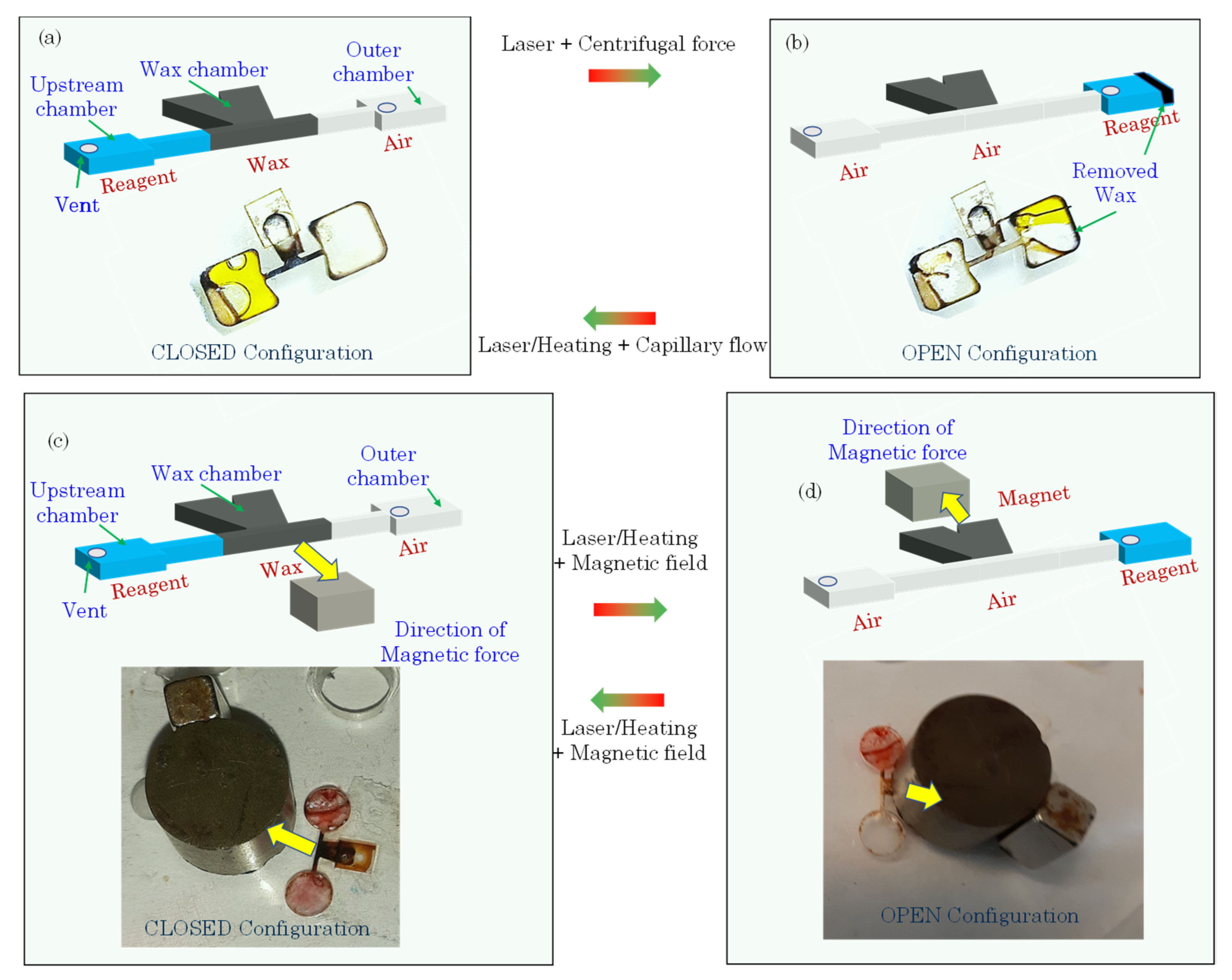
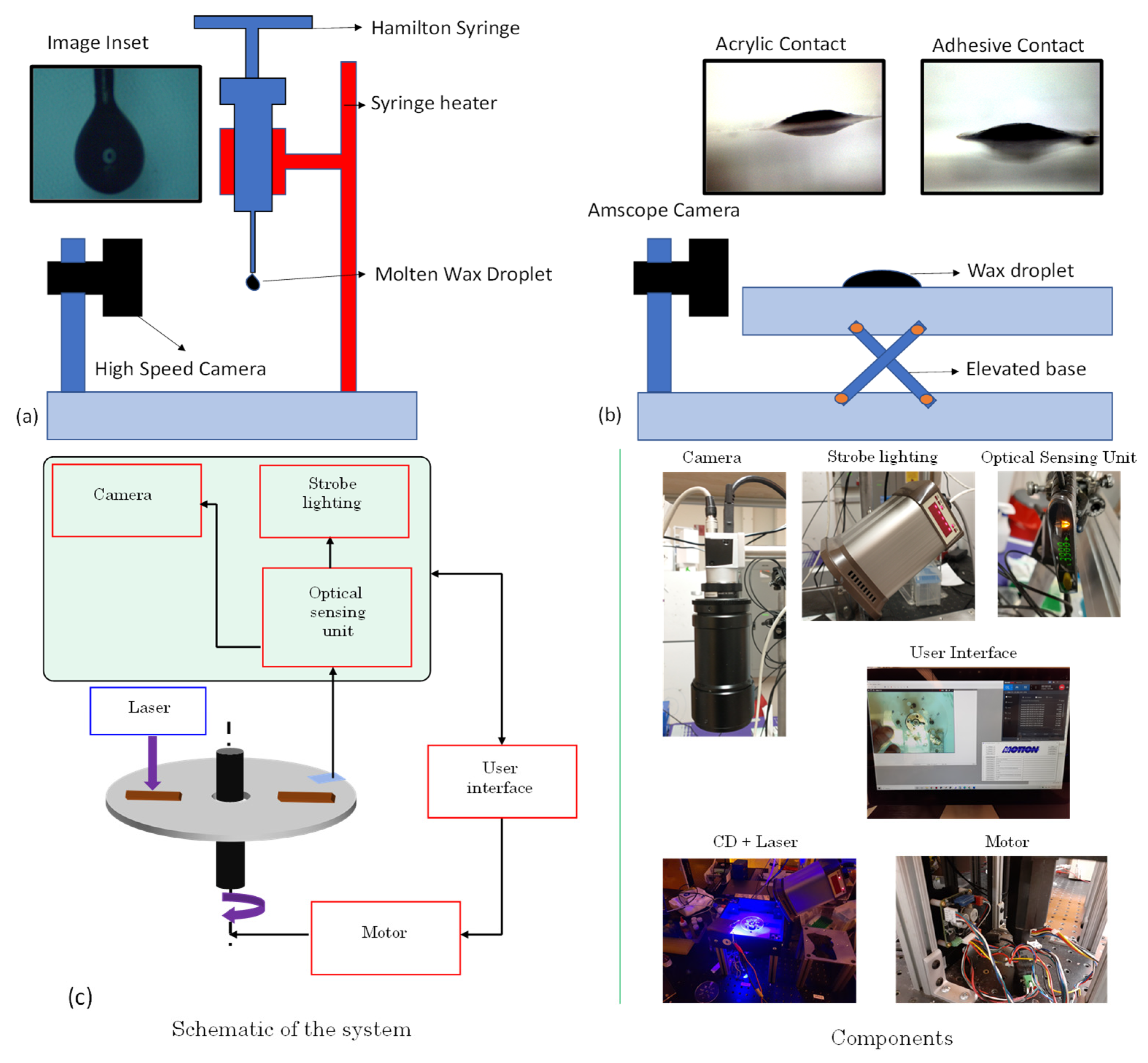
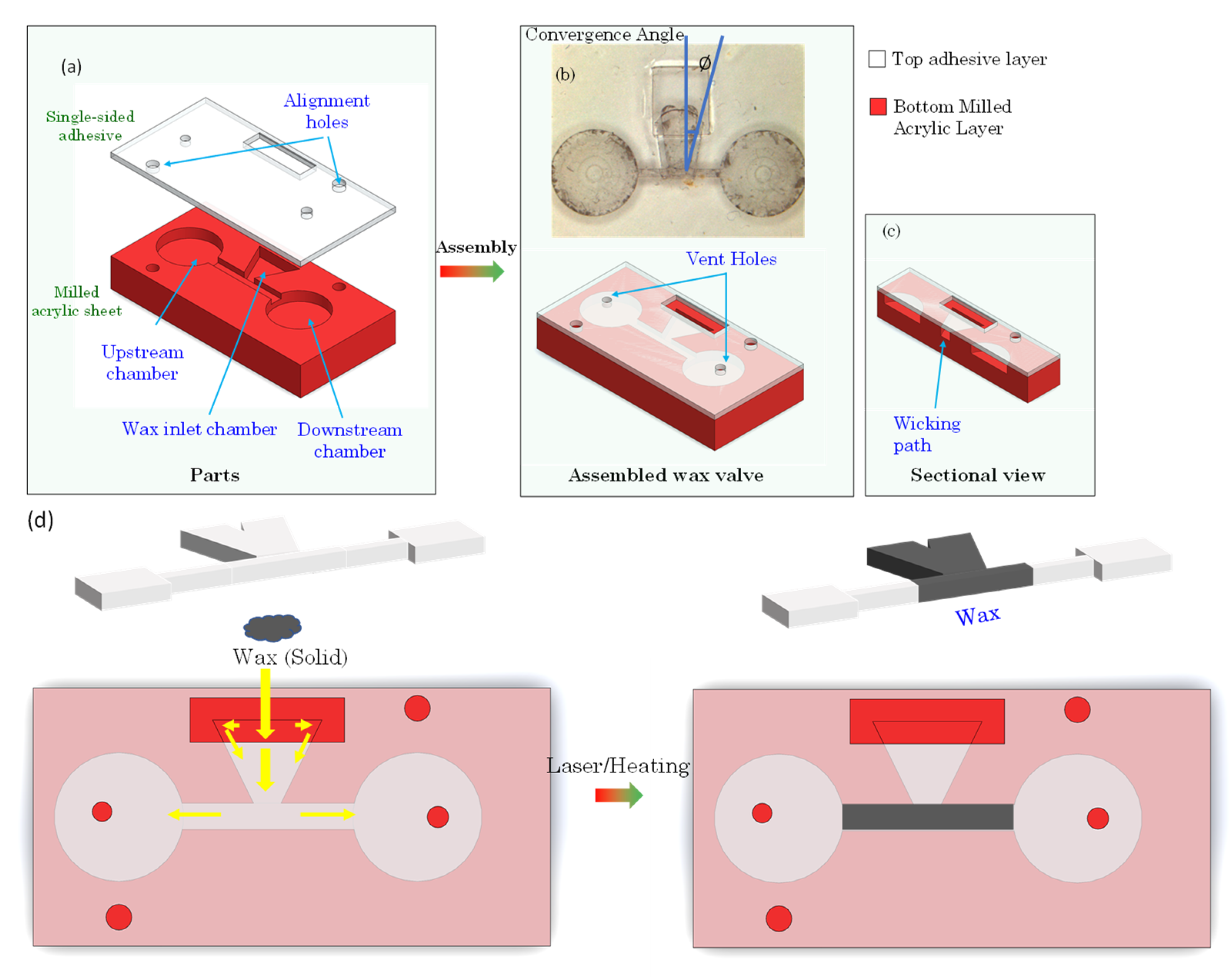
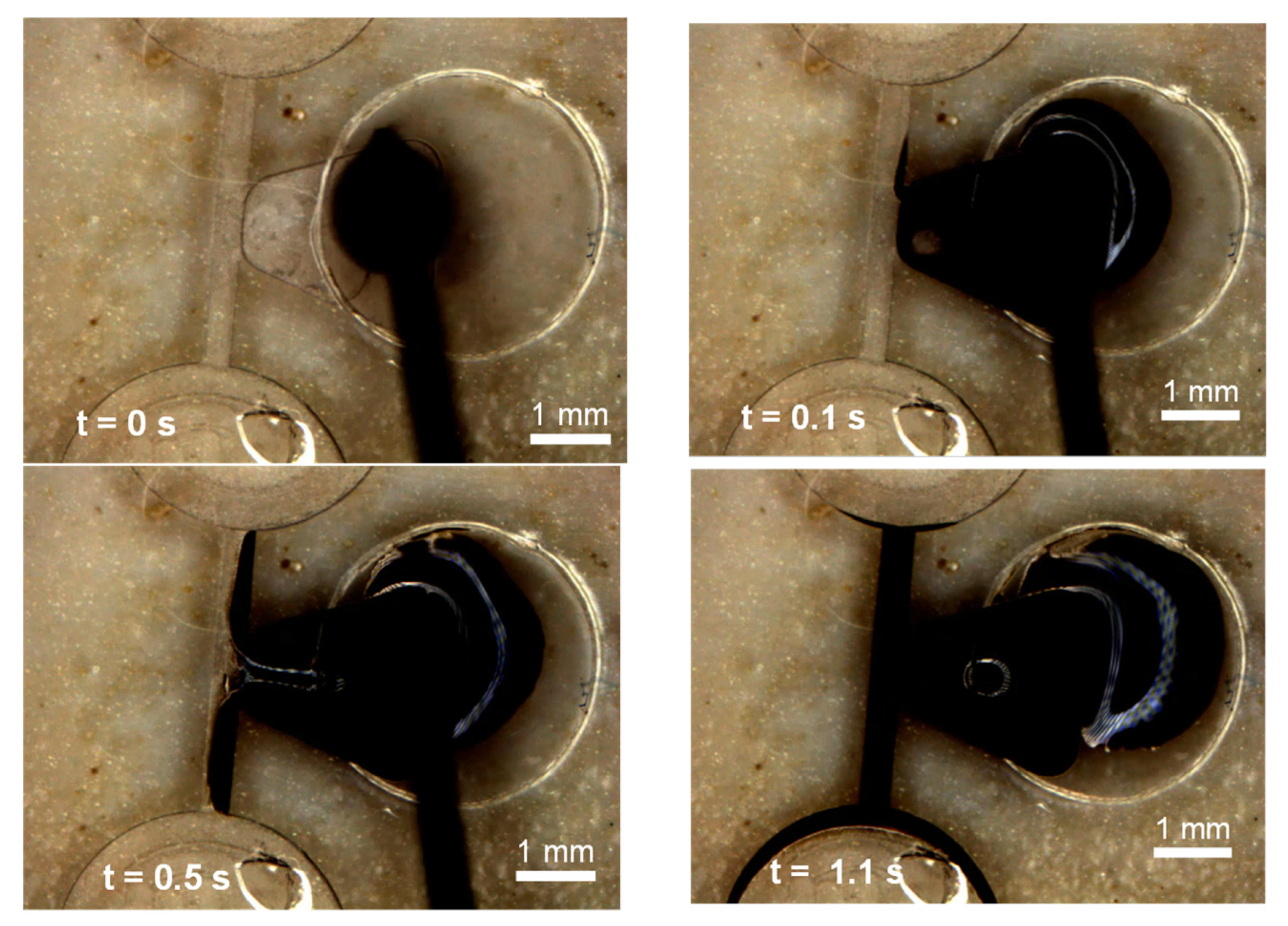
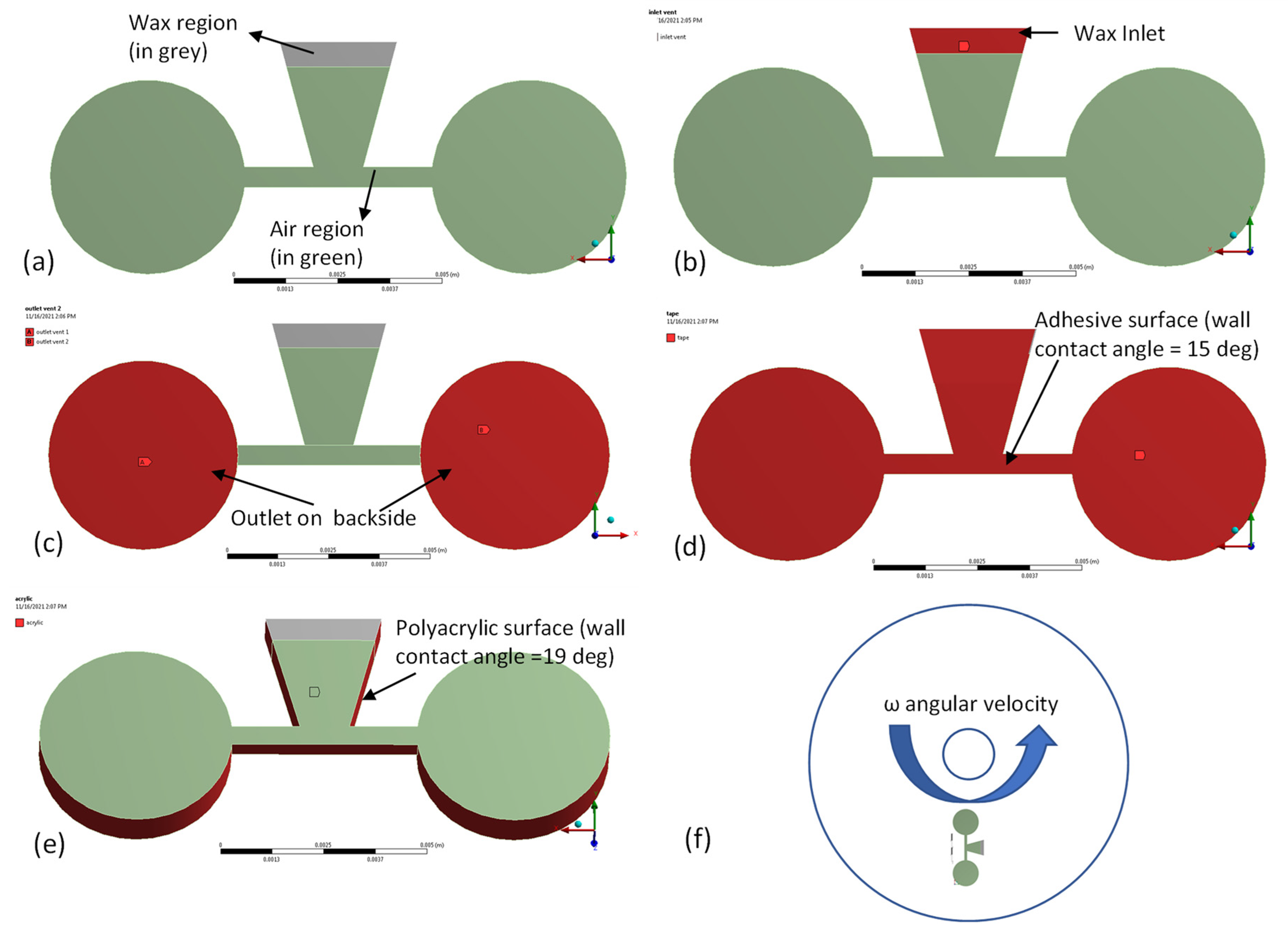
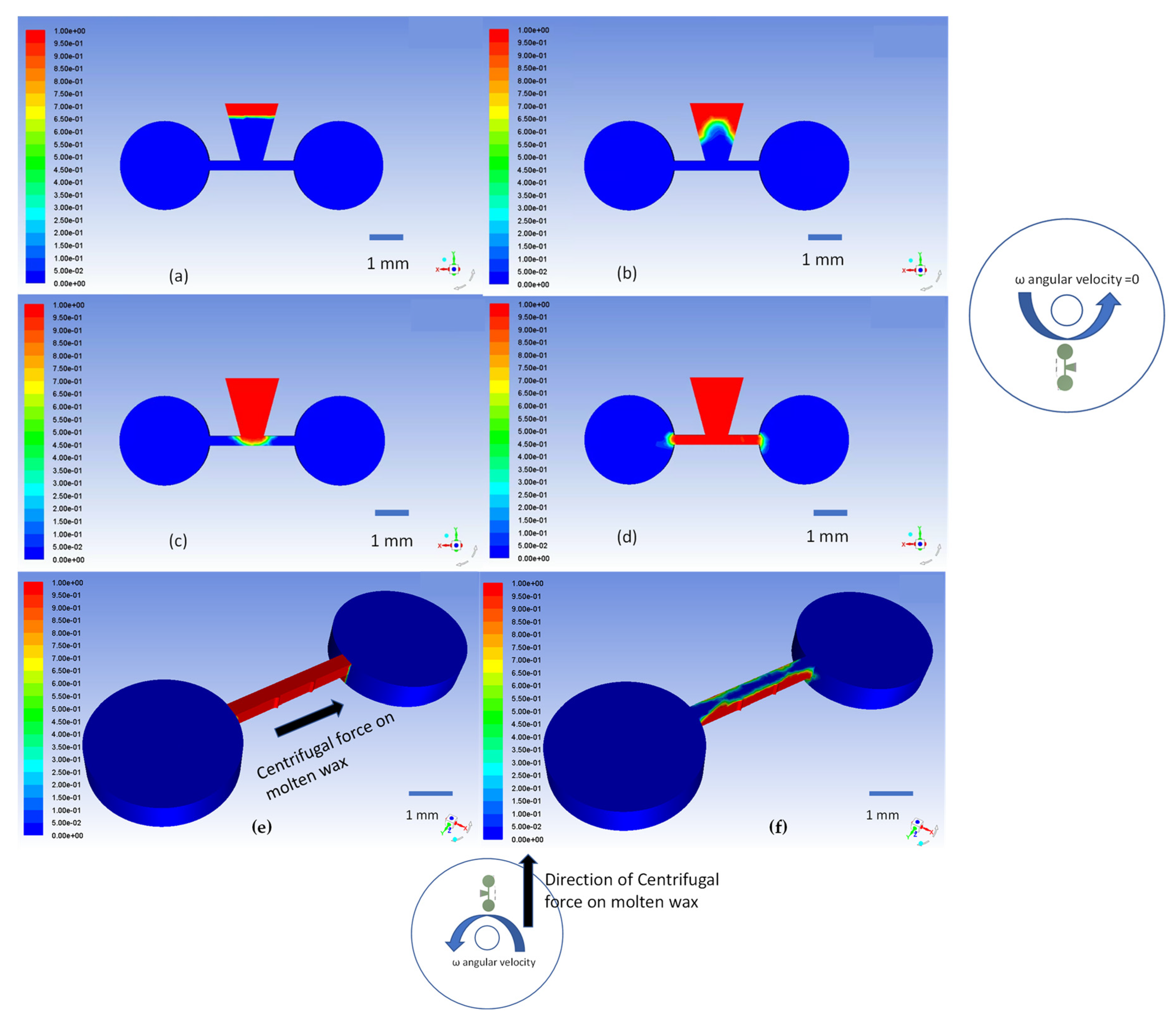
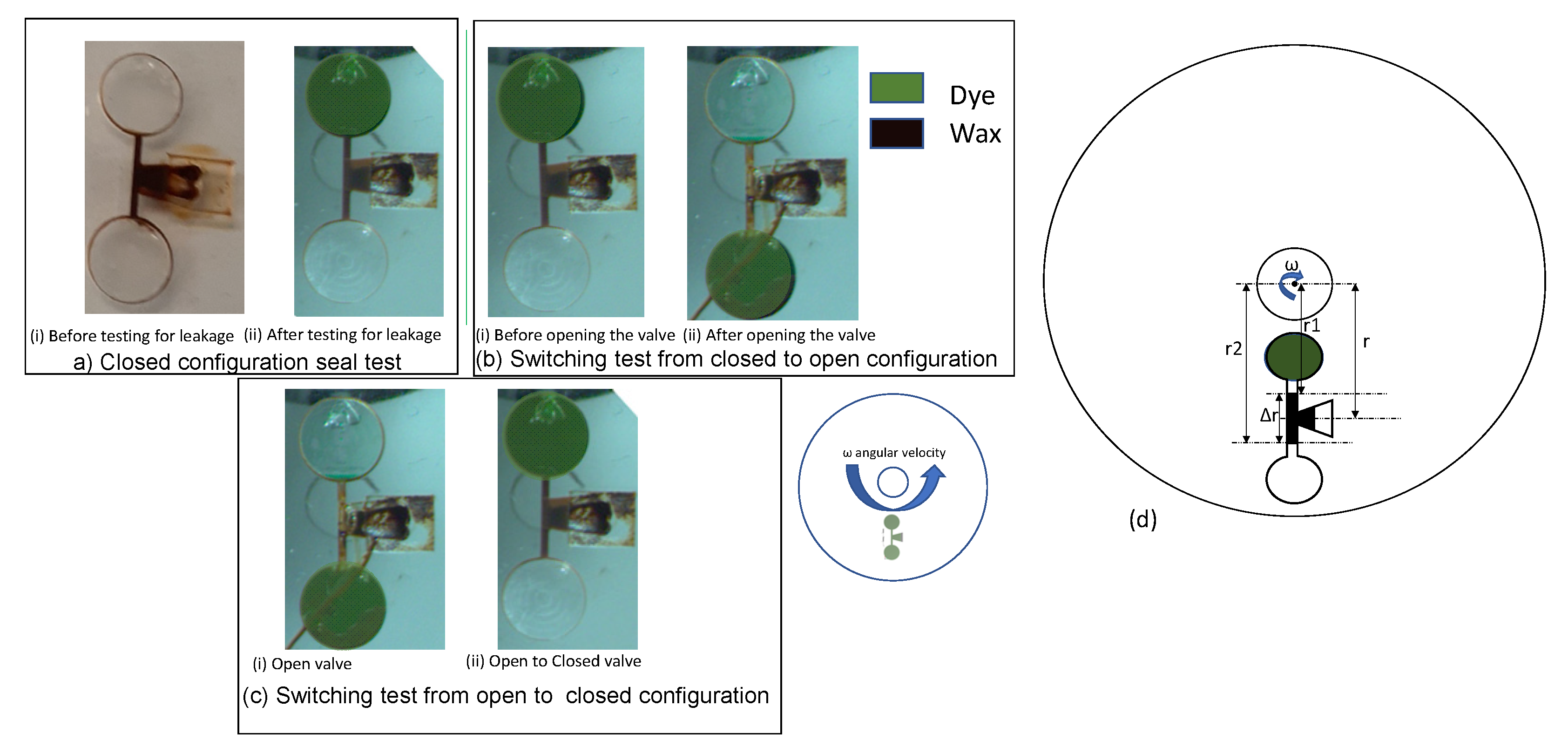

| Property Input Type | Value with Units |
|---|---|
| Density of ferro-wax [23], ρ | 760 kg/m3 |
| Surface tension of ferro-wax at 90 °C *, γ | 0.051 +/− 0.005 N/m |
| Viscosity of ferro-wax at 90 °C [23], μ | 0.00031 kg/m⋅s |
| Contact angle (acrylic surface) * ferro-wax, θc | 19 +/− 0.5° |
| Contact angle (adhesive) * ferro-wax, θc | 15 +/− 0.5° |
Publisher’s Note: MDPI stays neutral with regard to jurisdictional claims in published maps and institutional affiliations. |
© 2022 by the authors. Licensee MDPI, Basel, Switzerland. This article is an open access article distributed under the terms and conditions of the Creative Commons Attribution (CC BY) license (https://creativecommons.org/licenses/by/4.0/).
Share and Cite
Peshin, S.; George, D.; Shiri, R.; Kulinsky, L.; Madou, M. Capillary Flow-Driven and Magnetically Actuated Multi-Use Wax Valves for Controlled Sealing and Releasing of Fluids on Centrifugal Microfluidic Platforms. Micromachines 2022, 13, 303. https://doi.org/10.3390/mi13020303
Peshin S, George D, Shiri R, Kulinsky L, Madou M. Capillary Flow-Driven and Magnetically Actuated Multi-Use Wax Valves for Controlled Sealing and Releasing of Fluids on Centrifugal Microfluidic Platforms. Micromachines. 2022; 13(2):303. https://doi.org/10.3390/mi13020303
Chicago/Turabian StylePeshin, Snehan, Derosh George, Roya Shiri, Lawrence Kulinsky, and Marc Madou. 2022. "Capillary Flow-Driven and Magnetically Actuated Multi-Use Wax Valves for Controlled Sealing and Releasing of Fluids on Centrifugal Microfluidic Platforms" Micromachines 13, no. 2: 303. https://doi.org/10.3390/mi13020303
APA StylePeshin, S., George, D., Shiri, R., Kulinsky, L., & Madou, M. (2022). Capillary Flow-Driven and Magnetically Actuated Multi-Use Wax Valves for Controlled Sealing and Releasing of Fluids on Centrifugal Microfluidic Platforms. Micromachines, 13(2), 303. https://doi.org/10.3390/mi13020303









